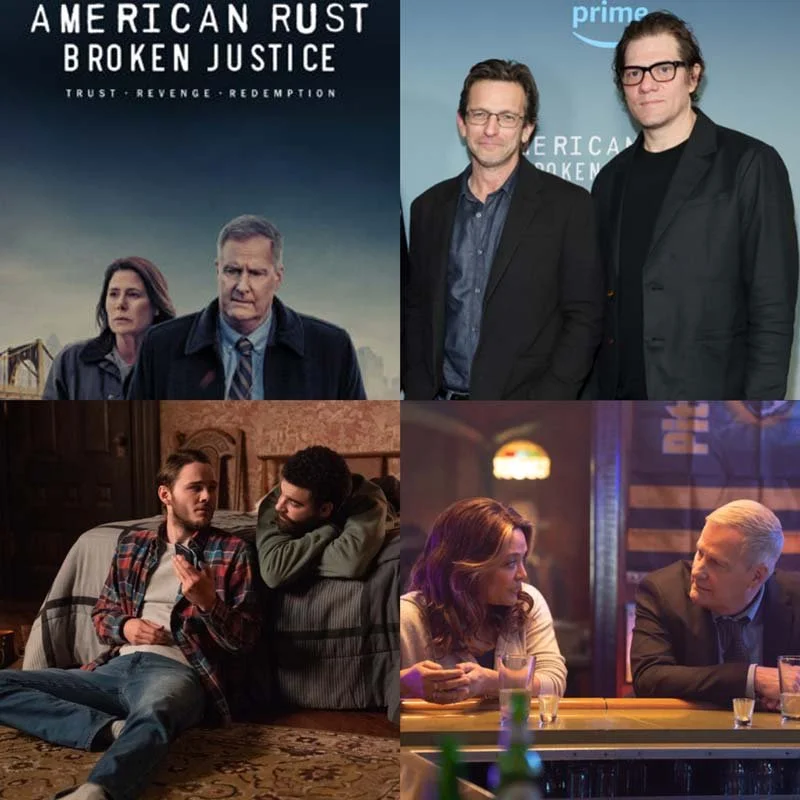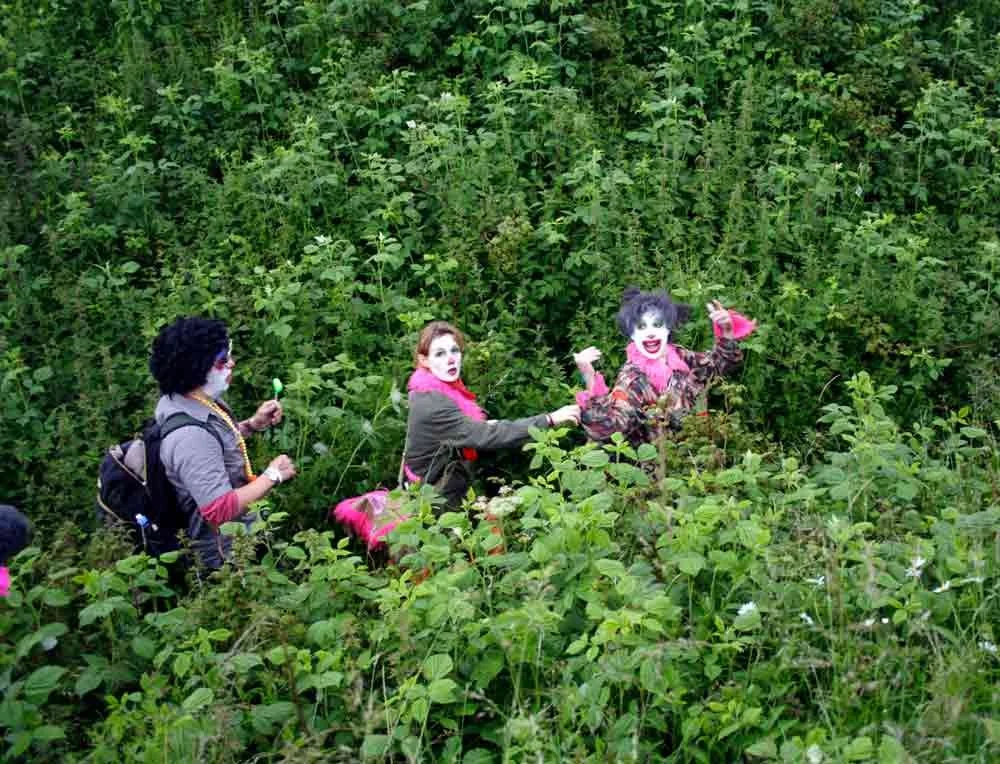How can we design and adapt for the uncertainties of the 21st century? How do emotions shape our decisions and the way we design the world around us?
Scott Doorley is the Creative Director at Stanford's d. school and coauthor of Make Space: How to Set the Stage for Creative Collaboration. He teaches design communication and his work has been featured in museums and in publications such as Architecture + Urbanism and The New York Times. Carissa Carter is the Academic Director at Stanford's d. school and author of The Secret Language of Maps: How to Tell Visual Stories with Data. She teaches courses on emerging technologies and data visualization and received Fast Company Innovation and Core 77 awards for her work on designing with machine learning and blockchain. Together, they coauthored Assembling Tomorrow: A Guide to Designing a Thriving Future.
Today, someone is putting the finishing touches on a machine- learning algorithm that will change the way you relate to your family. Someone is trying to design a way to communicate with animals in their own language. Someone is designing a gene that alters bacteria to turn your poop bright blue when it’s time to see the doctor. Someone is cleaning up the mess someone else left behind seventy years ago yesterday. Today, someone just had an idea that will end up saving one thing while it harms another…
To be a maker in this moment— to be a human today— is to collaborate with the world. It is to create and be created, to work and be worked on, to make and be made. To be human is to tinker, create, fix, care, and bring new things into the world. It is to design. You— yes, you!— might design products or policy, services or sermons, production lines or preschool programs. You might run a business, make art, or participate in passing out meals to the poor. You may write code or pour concrete, lobby for endangered species legislation or craft cocktails. Wherever you fit in, you are part of shaping the world. This is design work.
– Assembling Tomorrow
A Guide to Designing a Thriving Future
THE CREATIVE PROCESS · ONE PLANET PODCAST
You both teach at universities at a time when educational silos are in flux. Young people are living in this kind of giant laboratory of possibilities, innovation, inspiration, and experimentation, and things around us are changing so fast. The rapid advances of AI are challenging many norms, and Assembling Tomorrow really helps us put this into context. It's playful, imaginative, and thought-provoking, and it inspired me to consider: What’s the future that I want to live in? And how I can be a part of that design process? So, what made you write Assembling Tomorrow at this moment in time?
CARISSA CARTER
This moment feels really overwhelming. Like we're overwhelmed with the technology, our climate's on the fritz, and it can feel really unsettling. Yet at the same time, as people that craft learning experiences, we know how much agency each of us has as individuals. And so we wanted to write the book to call attention to the complexity and the feeling of overwhelm of this moment and then also to share things that anybody can do to launch ourselves into that better future.
THE CREATIVE PROCESS · ONE PLANET PODCAST
How important are emotions in the design process? And what are the emotional impacts of design?
SCOTT DOORLEY
So if you look at the internet and the creation of the internet, the idea was to move information quickly. And that has been great, but there have been a lot of things where they didn't take into account the fact that, well, there are people attached to all that information, and those people are experiencing emotions. The things that we're designing are actually exciting and aggravating our emotions. So you take something like social media, which is really about the speedy spread of information. And what you see is it also brought along with it teen depression and body image issues. It also led to political polarization.
THE CREATIVE PROCESS · ONE PLANET PODCAST
Carissa, you teach data visualization. How important is this in helping us understand, adapt and take action on climate change?
CARTER
One thing to know is that every single climate visualization that we see out in the world, whether that is a map of rising temperatures around the country or the globe or rising sea levels or wildfires, all of that has design decisions behind it. I am also with you that we need to get more people understanding the impacts of their own actions on climate change and being aware of what's happening to the planet. So one is to be able to interpret that work and really interrogate it for what it is. To be able to read any infographic and what we call deconstruct it, understand what emotions it is evoking in you, your gut reaction, why those are happening, and literally what the designer has done to make you feel that way. Literacy in reading infographics is one piece. And to give you very specific examples, in one of the classes that I teach and co-teach with a geoscientist, Kate Maher, and an infographic designer, Catherine Madden, we have students visualize what is known as the climate swerve. So this idea that humans, and the idea that we can't have agency over shifting climate, was coined the climate swerve by Jay Lifton a number of years ago. That concept is one that the more that we have people sourcing what the information is and how to present it, we feel gets that climate literacy in our brains and gets that message across. You can see it in really interesting ways. For example, we have students visualize climate anxiety and where it is cropping up, overlaid with where people should feel anxious about climate. We have even had a student group that visualized the themes of major Marvel movies throughout the past 20 plus years. They looked at what those themes were and how they changed and how some of the themes have started to be much more climate-related, kind of showing how these topics are ingrained in popular culture too.
Speculative Legislation: Preparing for the Future
DOORLEY
We have an assumption that technological innovation outpaces government regulation. That's a very well-founded assumption because that's how it goes. It's always been that way. However, I think we need to start thinking differently, and we should be able to imagine that we can create legislation that precedes the impacts of the things we're creating. If we see a potential effect coming, we should be able to put in a sort of preemptive law to address it prior to the effect actually happening, which we do in a lot of ways. There are tons of examples of that, but I think the pace of legislation needs to accelerate so that it can really grapple with the pace of technological innovation. But then if you do that, you have to be ready for the fact that the legislation might be off. It's speculative, it's anticipatory, and you're not necessarily going to get it right. I think we also need to build in mechanisms into the laws that make them responsive and changeable. So let's have speculative legislation. We'll put a law out there, a regulation that's speculative, but let's have built-in checks that are constantly checking if this is working the way we wanted it to, and it needs to be easy to change if it's not. Which is also not built into the system. We need to be able to imagine things working in ways in which we aren't used to them working. One, I think, is legislation being quick and responsive when generally it's sort of slow and hard to change. That's one thing that I think could really help.
CARTER
Scott and I like to kick around imaginative ideas for types of legislation. One idea is like a 'look both ways' technology where, let's say, we have a big new social media technology that's about to be launched, and AI and all sorts of algorithms that would fit within that bucket. Is there a moment where there's a trial period with technologies like that, where we have some ideas as to how they might need to be governed? We could put those in place and then use that, say, two-year period of time when that technology is learning how it's going to actually work once it's in place. We both look historically and see how similar technologies have affected our world. What should we be looking for in terms of the effects it might have both on our individual persons and our societies? Also, sort of look forward, do some visioning as to what might come to pass 10, 20, 30 years down the road.
THE CREATIVE PROCESS · ONE PLANET PODCAST
One of the things you write about are understanding the intangibles.
CARTER
Understanding the intangibles is really about knowing the forces that are coming together that are making this moment feel quite unsettling. These include the fact that everything is interconnected and flows between each other and the feelings that you were talking about before, as well as our human propensity to make stories and come up with narratives to connect ideas, whether they exist or not. Human characteristics and actionables are like: what are ways to notice those forces that are happening, to see the unseen so that each one of us can be more aware of what's happening and build the world for the better.
The Concept of Umwelt: Perception and Reality
DOORLEY
The way our brains work is not really indicative of how the world works. There's a reason for that. Us being able to pay attention to certain things and ignore others allows us to navigate, but it shouldn't be mistaken for an understanding of our holistic view of the world. There's a concept that we talk about in the book called the umwelt. The idea of an umwelt is what your senses can take in, and different species have different senses. As an example, cockroaches sense movement in ways that we don't. Butterflies can see infrared light, and we can't. Butterflies can actually taste with their feet, which is kind of an amazing thing, and I'm kind of glad that we don't. The point is that even through our senses, my understanding of a situation is going to be different from your understanding of the situation. The way I think of a story of what happens is going to be different from the way you thought of a story. There's a man named Gregory Bateson (author of Steps to an Ecology of Mind), who was an environmentalist, and he talks about how most of the problems in the world are actually a problem between the way people think and how the world works. They are not the same thing. The way we understand the world and how the world actually works is just not mapped perfectly. That kind of leads to problems because we don't know exactly what we're doing in the world. We can't see all the repercussions of the things we create until later on.
AI and the Future: Opportunities and Concerns
One silver lining about the technologies we're creating is that technologies like AI could be used to help us with this issue, with the fact that our mental models aren't exactly in line with how the world works. AI is actually very good at predicting and modeling outcomes. It could be used to understand climate change better so that we're able to understand it in a way that allows us to act. It could also help us predict the impacts of the things that we're making. So there's a bit of a silver lining in here, even though it can feel scary to be in a situation where your mental model and how the world works are not in line.
THE CREATIVE PROCESS · ONE PLANET PODCAST
As you reflect on AI, how do you feel it's going to change the future of education, the future of work, the way we communicate with ourselves, and our imaginations? We have been living in a digital smog for a long time, now combined with the manic pace of AI. So as our technologies change, how is it changing our sense of self?
CARISSA CARTER
Well, one is it's absolutely going to change us. I think the sooner that we can be very proactive, the better. I don't know if I want to be changed, and I think a lot of people are feeling that too. But it is going to change us, so it's not going to help to pretend like it's not happening. But we can all be proactive in noticing the changes it's having on us, on our children, on our planet, from every scale—from that large system-wide energy footprint scale all the way down to the minuscule. Maybe I won't even call it minuscule, but I worry that AI is changing my thoughts and can control my thoughts, and that used to sound really far-fetched and now seems sort of middle of the road. I guarantee in a year's time that will sound like a very normal concern. Social listening is very sophisticated. All of the data in the websites that we visit, the data trails that we leave out in the world, are tracking us—our locations, our behaviors, and our habits such that there are many sites out there that can predict exactly what we're thinking and feeling and feed us advertising content or things that aren't even advertising content that can change what our next behaviors are.
I think that's getting more and more sophisticated. We have already seen our political elections affected by mass attacks on our social media. When that comes down to our individual agency and behavior, I think that's something we do need to be concerned about. The way that we as individuals can combat it is to be aware that it's happening. Really start to notice the unnoticed, and I still feel optimistic amongst this concern.
When we are prototyping new design ideas with students, we love this mantra that the prototype should never be more resolved than the idea. So if you want to make a new chair and you're concerned with how much space it should take up, you make that thing out of cardboard so that you just get an idea of space. You don't make it at its final beautiful wood and leather resolution because then you're going to be looking at whether this texture feels right. You're not going to be thinking about the amount of space it's taking up. But with AI, you're right. The manicness, the hallucinations, when they appear exactly the same as something that we are used to as just a representation of search, etc., that's confusing. That is confusing to our brains, and if you're working quickly, you can miss it.
The Media Landscape: Protecting Our Imagination
DOORLEY
You mentioned digital smog, Mia, and something Carissa and I have been talking about lately is as you move from the industrial era to the media era, the landscape of what we're working with changes. In a media landscape, the environment is not just the trees and the water and the air. It's actually our minds—our emotions, our feelings, our mental models, and our imagination. So our brains are kind of the environment in which all these new media updates and designs are playing out. Where does pollution show up? Pollution shows up in political polarization, it shows up in difficulties with mental health. We need to think of our imagination in the media space as a public resource that needs to be protected. Our collective imagination, the sum total of our individual imaginations and how they affect each other, is really important to start thinking about with a conservation mindset. This is kind of a silent spring moment of the media era.
Creativity, Innovation and the Importance of a Holistic Design Process
DOORLEY
When you're thinking about a creative field or just bringing creativity to whatever field you have, creativity is often about finding the hidden thing, finding the thing that nobody else is seeing and taking it to reality. Don't think that make believe or imagination or weird ideas are not worth it. I had some mentors in my life that allowed me to understand how you should take make believe seriously, because if you go down this kind of wild path, you find something beyond what's going on, and eventually the world is going to normalize it and integrate it. Otherwise, it just won't work. So don't worry about being out there. We need people to be thinking beyond what is toward what could be. I think that's number one. The second thing is that the way you do things is as important as the things you do. It's not just about the product; it's about how you do it because how you do it actually has more repercussions sometimes than the product. You might create a great product, but if everyone working on it is angry and the people you're trying to serve aren't excited about it or they've been taken advantage of to make it come into the world, that leaves more bad stuff that's harder to see but has an equal or bigger impact. Just how you make it is as important as what you make.




















































